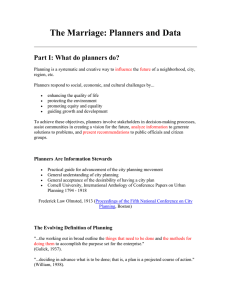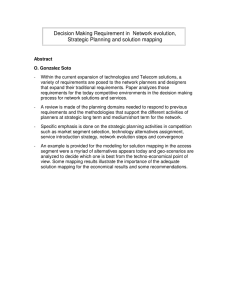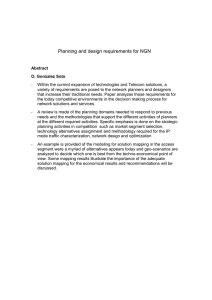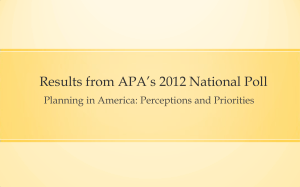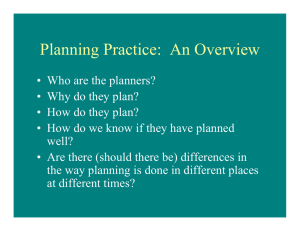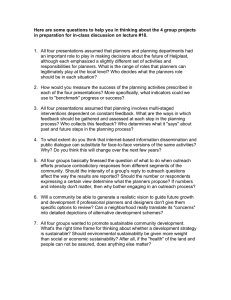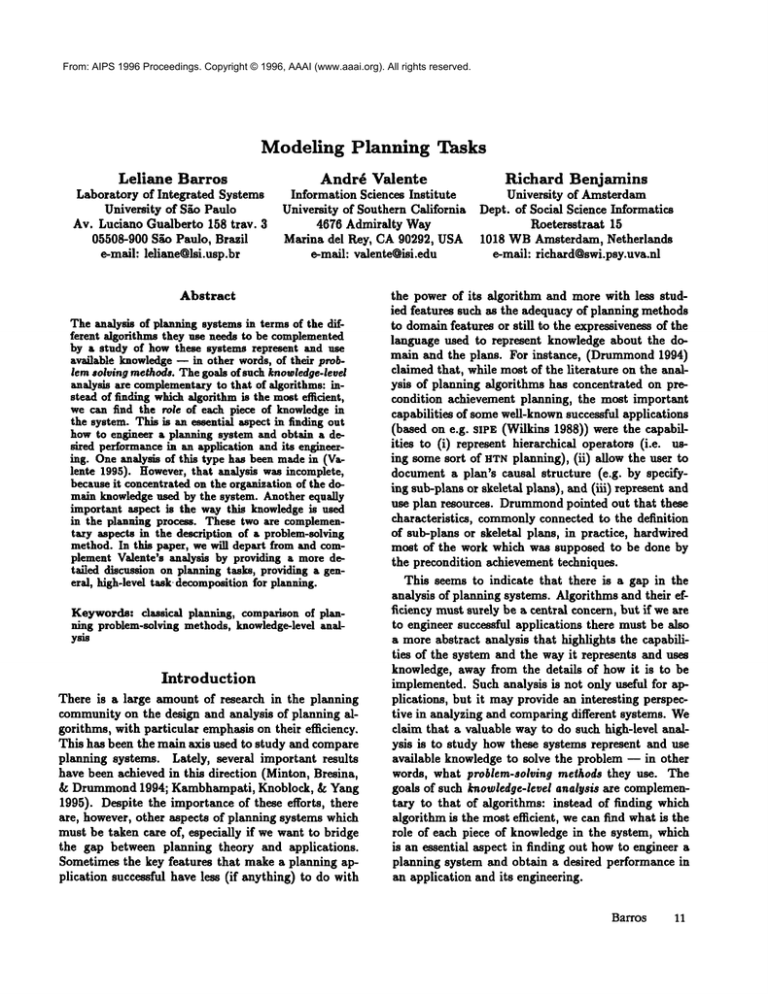
From: AIPS 1996 Proceedings. Copyright © 1996, AAAI (www.aaai.org). All rights reserved.
Modeling Planning
Leliane
Barros
Laboratory of Integrated Systems
University of S~o Paulo
Av. Luciano Guaiberto 158 tray. 3
05508-900 S~o Paulo, Brazil
e-mail: leliane@lsi.usp.br
Tasks
Richard
Benjamins
Andr6 Valente
University of Amsterdam
Information Sciences Institute
University of Southern California Dept. of Social Science Informatics
4676 Admiralty Way
Roetersstraat 15
Marina del Rey, CA90292, USA 1018 WBAmsterdam, Netherlands
e-maih richard@swi.psy.uva.nl
e-maih valente@isi.edu
Abstract
The analysis of planning systems in terms of the different algorithms they use needs to be complemented
by a study of howthese systems represent and use
available knowledge-- in other words, of their prob/era solving methods.Thegoals of such knowledge.level
analysis are complementaryto that of algorithms: instead of finding whichalgorithm is the most efficient,
we can find the role of each piece of knowledgein
the system. This is an essential aspect in finding out
howto engineer a planning system and obtain a desired performancein an application and its engineering. One analysis of this type has been madein (Valente 1995). However,that analysis was incomplete,
because it concentrated on the organization of the domain knowledgeused by the system. Another equally
important aspect is the way this knowledgeis used
in the planning process. These two are complementary aspects in the description of a problem-solving
method. In this paper, we will depart from and complement Valente’s analysis by providing a more detal]ed discussion on planning tasks, providing a general, high-level task. decompositionfor planning.
Keywords: classical planning, comparison of planning problem-solving methods, knowledge-level analysis
Introduction
There is a large amount of research in the planning
communityon the design and analysis of planning algorithms, with particular emphasis on their efficiency.
This has been the main axis used to study and compare
planning systems. Lately, several important results
have been achieved in this direction (Minton, Bresina,
& Drummond1994; Kambhampati, Knoblock, & Yang
1995). Despite the importance of these efforts, there
are, however, other aspects of planning systems which
must be taken care of, especially if we want to bridge
the gap between planning theory and applications.
Sometimes the key features that make a planning application successful have less (if anything) to do with
the power of its algorithm and more with less studied features such as the adequacy of planning methods
to domainfeatures or still to the expressiveness of the
language used to represent knowledge about the domain and the plans. For instance, (Drummond1994)
claimed that, while most of the literature on the analysis of planning algorithms has concentrated on precondition achievement planning, the most important
capabilities of some well-knownsuccessful applications
(based on e.g. sIPg (Wilkins 1988)) were the capabilities to (i) represent hierarchical operators (i.e.
ing some sort of HTNplanning), (ii) allow the user
document a plan’s causal structure (e.g. by specifying sub-plans or skeletal plans), and (iii) represent
use plan resources. Drummondpointed out that these
characteristics,
commonlyconnected to the definition
of sub-plans or skeletal plans, in practice, hardwired
most of the work which was supposed to be done by
the precondition achievement techniques.
This seems to indicate that there is a gap in the
analysis of planning systems. Algorithms and their efficiency must surely be a central concern, but if we are
to engineer successful applications there must be also
a more abstract analysis that highlights the capabilities of the system and the way it represents and uses
knowledge, away from the details of how it is to be
implemented. Such analysis is not only useful for applicatious, but it mayprovide an interesting perspective in analyzing and comparing different systems. We
claim that a valuable way to do such high-level anaiysis is to study how these systems represent and use
available knowledge to solve the problem -- in other
words, what problem-sobJing methods they use. The
goals of such knowledge-level analysis are complementary to that of algorithms: instead of finding which
algorithm is the most efficient, we can find what is the
role of each piece of knowledge in the system, which
is an essential aspect in finding out how to engineer a
planning system and obtain a desired performance in
an application and its engineering.
Barros
11
From: AIPS 1996 Proceedings. Copyright © 1996, AAAI (www.aaai.org). All rights reserved.
There are several efforts in what we regard as a
knowledge-level analysis of planning. For example, a
large part of the research in formal models of planning can be seen in this perspective. Further, efforts
in the specification of ontologies of planning (e.g. the
KRSLstandardization effort 1) have the same flavor.
This paper expands on and complements the analysis of conceptual models of planning methods made by
(Valente 1995). His work is based on the representation of problem-solving methods in conceptual terms,
in the tradition of KADS(Schreiber 1992). Valente
focused his analysis on what types of domain knowledge are used in planning systems, and how this knowledge is structured. However, another equally important aspect which was only briefly discussed in (Valente 1995) is the way this knowledge is used in the
planning process. These two are complementary aspects in the description of a problem-solving method
k respectively
the domain and task knowledge. In
this paper, we extend this work by providing a more
detailed discussion on models of planning tasks. We
provide a general, high-level task decomposition for
planning, and show how different planning systems (i)
instantiate this decomposition by executing its steps
using different methods, and (it) impose different control structures to control the inferencing process. It is
important to note that we maintain the same focus of
(Valente 1995) in that we are not modelingall possible
types of planning systems (e.g. re-planning, planning
agents, reactive planning systems), but only systems
that elaborate a plan to achieve a numberof goals (or
a final state) -- this is what we mean by "planning"
in the remainder of this article.
Ingredients
of a Task
Analysis
Approaches to knowledge-level analysis and modeling include Role-limiting Methods (Marcus 1988) and
CommonKADS
(Schreiber 1992). Their common characteristic is to define a set of high-level components
which are used to express problem-solving knowledge. CommonKADS
(also known in earlier versions
as KADS)is a methodology for developing knowledgebased systems, created during a multi-year research
effort that has included several ESPRIT projects.
Briefly, the components used to represent problem2solving knowledge in KADSare:
Tasks are represented using a functional perspective, i.e. specified by input/output relations which is
called in KADSa flnction. A function also includes a
-1See the Webpage http://www.aiai.ed.ac.uk/’bat/krsi
plans.html
2For clarity, the original KADS
terminology has been
simplified in someplaces.
12 AIPS-96
goal i.e. a specification of what needs to be achieved.
For example, the goal of planning task is to come up
with an ordered sequence of operations that transforms
a given initial state into a goal state. Werepresent
the input and output by roles that knowledge plays in
the problem-solving process. For instance, an input
or output role like hypothesis means that some domain
structure or element plays the role of hypothesis. Static
roles are the ones whose contents do not change during
problem solving (they correspond roughly to a knowledge base in a knowledge-basedsystem); dynamic roles
are the ones that do change.
Problem-solving
methods (PSMs) describe how
the goal of a task can he achieved. A method has input and output roles, and either decomposesa task into
subtasks (composite method), or is primitive. Tasks
and PSMScan he organized in a task-method decomposition structure, where a task maybe realized by alternative methods, each of which consists of subtasks
or is primitive. Fig. 2 presents such a diagramfor planning. A primitive method can usually be implemented
by a general or weak method (e.g. constraint propagation). A composite method specifies the allowed data
flow (in terms of their roles) between the subtasks, and
the control knowledge over them. Control knowledge
is represented by a control structure, which determines the execution order and iteration of the subtasks.
In the specification of a control structure there is no
concern for precision (e.g. defining what is the actual
content of symbolic variables). Instead, we only wish
to describe the overall control regime. Without being committed to a particular control structure, the
subtasks of a PSM form a function-structure,
that
captures the data flow between the subtasks. Wewill
show an example of a function-structure and a control
structure later in the paper.
Domain Ontologies provide a vocabulary that can
be used to describe a certain domain. An ontology
specifies the concepts, relations, etc. independently
from the specific system that is reasoned about. Examples of domain ontologies in planning domains are
the formalisms to represent the world, time and actions, such as the situation calculus or the event calculus. Wewill not deal further with domain onto]ogles
in this paper. Domain models are structures built
using elements of the domain ontology to be used in
problem-solving methods. Typical examples are models that specify causal dependencies between symptoms
and diseases in medical domains (causal model),
models that specify structural hierarchies for physical
devices (structural models). Wewill discuss typical
domainmodels for planning tasks in the following section.
From: AIPS 1996 Proceedings. Copyright © 1996, AAAI (www.aaai.org). All rights reserved.
Knowledge Roles in Planning
The basic problem solved in planning tasks is to generate a sequence of actions (a plan) whose execution
achieves a given goal state. A planning problem is
characterized by two inputs: an initial state and a goal
state description of the world. One of the critical elements in the analysis of a planning methodis to specify
what types of knowledge it employs -- in other words,
which roles knowledgecan play. In this section we will
present (i) a set of four general dynamicroles in planning tasks; (ii) part-of or ganization of sta tic rol es,
originally defined in (Valente 1995). These two sets
give a high-level view on what types of knowledge are
used in planning, both in the sense of the knowledge
which is input or output to the task and which is used
as part of the knowledgebase.
all planning methodsuse causal links in their representation of plans, as we will discuss later.
Conflict The role conflict contains the result of
checking the plan with respect to the validity of a
condition. Each time when a condition is unexpectedly false, a conflict is detected. Whena plan has
to achieve multiple goals (i.e to make true multiple
conditions), conflicts easily arise because of interacting actions. The conflict role points to a plan-step that
violates some interval of truth value of a condition.
A conflict can also mean an inconsistency in the plan
constraints. This knowledge role is only used by some
planners, in particular the ones that explicitly modify
generated plans.
Dynamic Roles
Static
Current state The role current state is initially
filled by a description of the world in the beginning of
the plan, and later it is modified to contain intermediary states in the plan.
The part-of organization of static roles proposed in
(Valente 1995) is shown in Fig. 1. The rationale behind this part-of tree of static roles is twofold. First, it
means that all planning methods use a certain configuration of these roles. The minimal case is to have a
single domainmodel to play the role of plan model, but
more specific configurations mayoccur as well. Second,
the reason whythese roles represent a part-of tree is because they are interdependent, and thus should maintain coherence. They represent parts of the description
of the same whole: the terms or structures defined in
one part are used or referred to in another.
The plan model defines what a plan is and what
it is made of. It consists of two parts: the world description, which describes the world about which we
are planning, and the plan description, which describes
the structure and features of the plan being generating. Belowis brief description of these roles and their
sub-roles.
Goal The role goal describes the world state that
has to be achieved by the plan. The content of goal
is a set of conditions. Initially this role points to the
original goal to be achieved. During the planning process the content of the role is dynamically modified by
establishing new suhgoals and deleting achieved goals.
Plan The dynamic knowledge role plan is a composite role whose content is constantly modified during
the planning process until a solution is found. It consists of:
(1) Plan-steps which correspond to unique action
instances, along with their pre-conditious and the conditions that they can achieve..
(2) Ordering constraints over the plan-steps, such
as that one action precedes another. The type of order
imposed on the plan-steps in the plan (e.g. partial or
total) depends on the static role plan structure (which
will be described later) employed by the planner.
(3) Variable bindings which keep track of how
variables of plan-steps are instantiated with domain
knowledge such as objects, resources and agents.
(4) Causal links that represent causal connections between the plan-steps and the conditions they
achieve. Wedefine a causal link by (i) a condition
the plan that has to be true (e.g. a g0al condition), (ii)
a plan-step that needs this condition to be true and
(iii) another plan-step that makesthis condition true.
,
In schema: plan-step1 condition, plan-step2.
A causal link
defines an interval of truth value for a condition. Not
Roles:
the Plan
Model
World Description
The world description
role
comprises two sub-roles, state description and state
changes. The state description comprehends the knowledge necessary to represent or describe the state of the
world. Examples of domain models to play this role
in planning systems are a set of first order predicates
(STRIPs-like) or a set of fluents from the Situation Calculus. The state changes role comprehends all the information connected to the specification of changes in
the state of the world. This is also the specification of
the elements a plan is composed of (but not how they
are composed, see plan composition below). Examples
of domain models to play this role in planning systems
are the add-delete lists (ADL)used in STRIPS,or SOVP
procedures as in NOAH.
Batros
13
From: AIPS 1996 Proceedings. Copyright © 1996, AAAI (www.aaai.org). All rights reserved.
STATE
WORLD
DESCRXPTION
PLAN
~
DBSCRI
PTION
STATS CHANGBS
MODEL
PLAN ASSESSMENT
KNOWLEDGE
PLAN
DBSCEIPTION
/
/
~
PLAN
STRUCTURE
PLAN
C~POSZTION
~ STATE
cHANGE
DATA
Figure 1: Part-of tree of static roles in planning.
Plan description The plan description role comprises two sub-roles: plan structure and the (optional)
plan assessmentknowledge:
(1) Plan structure This role specifies how the parts
of a plan (actions, sub-plans) are assembled together.
It also specifies (indirectly) howthe plan is to be executed. There are several varieties in the structure of
plans that can be identified in the literature. They can
be described by two main knowledge roles: the plan
composition role contains the description of the plan
with respect to how the state changes are arranged in
order to make up a plan. This includes, for instance,
whether the plan will be a partial or a total ordering
of a set of state changes, or whether it includes iteration or conditional operators. The composition may
also be hierarchical: plans are composedof s,b-plans,
and so on up to atomic plans, which are normally state
changes. The state change data role contains the plan
information besides the structure of state changes. For
example, important state change data are interval constraints for binding the variables involved in the state
changes. It is also possible to assign different resources
to each state change or sub-plan. Two particularly
important resources are agents and time.
(2) Plan Assessment Knowledge determines
what kind of factors makea certain plan (or sub-plan)
better then another, and how they are to be taken into
account (e.g. weighted). Based on this knowledge
plan can be either criticized or modified. An example of plan assessment knowledgeis the truth-criterion,
which is used to find out if a condition is true at some
point in the plan. TWEAK
(Chapman 1987) uses
modal truth criterion (MTC)which defines when a particular condition in a plan is necessarily or possibly
true by formally stating all possible interaction problems. Another example of a domain model for "hard"
plan assessment knowledgeis the causal-link protection
used in SNLP(McAllester & Rosenblitt 1991) (see discussion below).
14 AIPS-96
A Framework
for
Modeling
Tasks
Planning
Based on an analysis of manyclassical planning systems, we have identified several relevant tasks and
problem-solving methods. They can be organized into
a task-method decomposition structure (see Fig. 2),
where a methodconsists of (solid lines) subtasks and
(sub)task can be realized by alternative (dashed lines)
methods. Ellipses represent tasks and rectangles methods.
Weclaim that the class of planners we are dealing with share a general, high-level problem-solving
method which we call propose-critique-modify (PCM).
That is, all planners contain in one way or another
these three basic tasks: (i) propose e~ansion, (it) cr/tiqae plan and (iii) modify plan. Of course, planners
differ in howthey achieve each of these steps; that is,
in what methods they use to perform these three tasks.
These differences also reflect their choices in terms of
how planning knowledge is represented. Fig. 2 shows
a set of PSMswe have found in the literature to realize these tasks 3. The tasks presented in Fig. 2 can be
described as follows:
Propose expansion has the goal of generating a
new step in the planning process in order to achieve
a selected goal. The input knowledge roles for this
task are: world description4, plan structure and plan assessmentknowledge. To realize this task, we found a
method called propose I, which can be decomposedinto
three sub-tasks: select goal, select operator and test for
unachie~ed goals.
aIt is interesting to note that the idea of proposinga
single high-level methodfor a class of problemsis not new.
(Chandrasekaran 1990) proposes a similar method, also
called propose-critique-modify,to solve design problems.
4Sayingthat this knowledgerole is an input implies that
the knowledgeroles that havea apart-of" relation with this
role, are also inputs for the task.
From: AIPS 1996 Proceedings. Copyright © 1996, AAAI (www.aaai.org). All rights reserved.
i
I
....... ;~...
.o,
~
:
oO,
t’ l
Figure 2: A task-method decomposition structure
Select goal This task selects a goal from the set
of goals to be achieved. For select goal four methods can be used: linear select, hierarchical select, random select and smart select. STRIPSchronologically
selects the last goal established by its search strategy (Fikes & Nilsson 1971), which we call linear select. NONLIN
(Tate 197.7) selects goals depending
some hierarchical levels assigned on the preconditions.
SNLP(MeAllester & Rosenblitt 1991) randomly selects
goals from the set of pending goals. It is also possible to select s goal in a more intelligent mannerwhich
minimizes possible future modifcations (smart select)
(Drummond& Currie 1989). In this case, the method
uses the static role plan assessment knowledge to select a goal. An example of smart select was proposed
by (Kambhampati, Knoblock, & Yang 1995), where
goal-selection strategy is described called MTc-based
goal selection, which selects a goal only when it is not
necessarily true according to the modal truth criterion.
Select Operator Select operator takes the selected
goal and the plan-step for which the goal is a precondition, and selects an operator. This can be a new
operator which is included in the plan. But it can also
be an operator which is already in the plan, in which
case an ordering constraint is added in such a way that
the operator is before the plan-step that needs the goal.
Whena new operator is included in the plan, its preconditions are added to the set of goals. The select
operator task can be realized by two methods. The
goal-driven select, selects an operator whoseeffect indudes the selected goal, constraining the order to be
necessarily before the selected goal. This method is
for planning.
used by SNLP and REFINEMENT
SEARCH
planning algorithms. The smart select method is applied by STRIPS
and PRODIGY which are implemented by means-end
analysis, and exploits the difference between the goal
state and the current state to select an operator.
Test for unachieved goals This task checks the
current plan for unachieved goals, and records them
in the dynamicrole goal. It also tests if the preconditions (sub-goals) of an operator are already achieved
the current state (when the plan composition is totalorder). Weidentified two methods to realize this task:
the MTC-based
goal-test and the current-state goal-test.
Causal-link based planners do not realize this task,
since they ensure that goals once achieved, are preserved.
Critique Plan The task critique plan checks for
conflicts and the quality of the plan generated so far,
using plan assessment knowledge. The role plan assessment knowledge can point to "hard" constraints
(plan interaction and the satisfiability of the plan constraints) and "soft" constraints (the factors that define
when a given plan is better than another. Weidentified one method to realize this task which we called
critique I. This method can be decomposed into two
subtasks: consistency critique and interaction critique.
Consistency critique This task checks the consistency of the constraints imposed on the plan generated so far. The constraints concern the action ordering and the co-designation of variables. More complex
planning systems can also check the consistency of the
assigned resources and agents. Weidentified the conBarros
15
From: AIPS 1996 Proceedings. Copyright © 1996, AAAI (www.aaai.org). All rights reserved.
STRIPS
HStatic role
world description
plan composition
Domain knowledge
ADL-based
total-order
PRODIGY
world description
plan composition
ADL-based
totai-order
NONLIN
world description
plan composition
plan assessment
HTN-based
partial-order
cansai-link protection
TWEAK
world description
plan composition
plan assessment
ADL-based
partial-order
truth-criterion
SNIP
world description
plan composition
plan assessment
ADL-based
partial-order
causai-link protection
Task
select goal
select operator
test for unaf.hievedgoals
select goal
modify plan
select operator
test for unadtievedgoals
select goal
select operator
critique plan
modify plan
select goal
select operator
critique plan
modify plan
test for unachievedgoals
select goal
select operator
critique plan
modify plan
Realizing method
linear select
smart select
current-st&tegoal-test
randomselect
ordering-selection
smart select
current-state goal-test
hierarchical select
goai-drivenselect
cansal-link based
cansal-link based
randomselect
goai-drivenselect
MTC-based
critique
MTC-basedmodification
MTC-based
goai-test
randomselect
goal-driven
cansal-link based
cansal-link based
Table 1: Mappingof some main planners into the proposed framework. Listed are the static roles used, the domain
models which fill these roles ("ADL"stands for "add-delete list"), the tasks and their realizing problem-solving
methods.
attaint propagation methodto realize this task.
Interaction critique Whenchecking for conflicts,
this task verifies whether the selected operator for
achieving the goal would interact with other goals in
the plan, and, whether the other operators already
in the plan would interact with the intended goal to
achieve. Although these two verifications
seem the
same, the second checking is sometimes included in
the task select operator. Note that this task involves
explicit reasoning about interactions. For realizing the
interaction critique task, we identified two methods:
(i) the caasal-link-based critiqee, which checks if the
plan-step interacts with the conditions of the causal
links; and (ii) the MTC-basedcritique, which uses the
modal truth criterion to check the existence of a step
that possibly interacts with the selected goal.
the plan in such a way that the conditions in conflict
are necessarily true. Both methodsare used in partialorder planners. The ordering selection is used for totalorder plans to select a point in the plan where to insert
an operator such that the conflict can be avoid.
Modify plan The modify plan task is responsible for modifying the plan with respect to the results
of the critique plan task (a conflict). By using plan
assessment knowledge a modification can be done by
adding ordering, binding or secondary preconditions
to the plan until the possible conflict (violation)
solved. Weidentified three methods to realize this
task: the caasal-hnlc-based, the MTo-based and the
ordering-selection plan modification. The cansal-linkbased method adds causal links to the plan which prevent the conditions contained in conflict from being
undone. The MTc-based method adds constraints
to
Mapping Planners
into the Framework
Table 1 shows how our framework characterizes a number of important planners by mapping their choices
in each of the three dimensions (static knowledge
roles, domain knowledge, tasks and methods). The
table contains the mappings for five different planners: STRIPS(Fikes & Nilsson 1971), PRODIGY
(Carhonell & the PRODIGYResearch Group 1992), NONLIN (’fate 1977) SNLP(McAllester & Rosenblitt 1991),
and TWEAK
(Chapman 1987).
The second column of Table 1 gives the static roles
used in the planners. All planners use world description
16
AIPS-96
Applying
the
Framework
In the previous sections, we proposed a frameworkfor
modeling(at a high level) all methodsused in planners.
This implies that it should be possible to describe a
planner on three dimensions: (i) the static knowledge
roles it uses (Fig. 1), (ii) a set of domainmodels
fill these roles, and (iii) a function-structure generated
through the selection of some tasks and methods from
Fig. 2. In this section, we will justify the above claim
by showing this mapping for a number of well-known
planners.
From: AIPS 1996 Proceedings. Copyright © 1996, AAAI (www.aaai.org). All rights reserved.
and plan description, but only the planners that explicitly reason about interactions use the plan assessment
knowledge role. The third column shows that STRIPS
and PRODIGY
are total-order
planners, whereas the
other three are partial-order planners. Except for NONLIN which is a HTNbased planner, all planners use ADL
operators (third column). As can be seen in the fourth
column, partial-order planners use dedicated tasks for
critiquing and modifying the plan (total-order planners
solve this by backtracking). Due to space limitation,
we refer to the fifth coTumn
of the table for the different
PSMsused to realize the tasks.
Based on the table, we can identify different types of
planners depending on how they relate to the following characteristics: linear or non-linear; total-order or
partial-order; truth-criterion or causal-link-protection.
In the following, we will concentrate on the most intereating types which are also discussed in the planning
literature.
Total-order/linear
(STRIPS). Such planners use
total-order domainmodel for the role plan composition;
a linear select methodfor the goal selection task; the
current-state goal-test method for the task "test for
unachieved goals"; the smart selection method for the
task "operator selection"; and they do not use plan
assessmentknowledge.
Total-order/nonlinear
(PRODIGY).
Such planners
use a total-order domain model for plan composition;
the randomselect methodfor the select goal task; the
ordering-selection method for modify plan task and the
current-state goal-test for the test for unachievedgoals
task. They usually do not use the role plan assessment
knowledge.
Partial-order/truth
criterion
(TWEAK, NONLIN). Such planners use a partial-order domain model
for plan composition; the MTc-based domain model for
plan assessment knowledge; the "test for unachieved
goals" task with the MTC-6asedmethod. They do not
make use of causal-links for bookkeeping.
Partlal-order/causallink-protection (SNLP). Such planners use the causallink dynamic role to keep track of how the goals have
been established; the causal-link-based domain model
for filling the static role plan assessment; they use the
tasks "critique plan" and the "modify plan", but not
"test for unachieved goals".
An Example: Mapping TWEAKFor illustration,
we detail here how TWEAK
can be mapped onto the
proposed framework. TWEAK
is a partial-order planner
that solves conflicts by explicitly reasoning about them
and modifying the plan. Fig. 3 shows its functionstructure, where individual functions or tasks are rep-
Figure 3: A function-structure for TWEAKaccording to
the proposed mapping. Rounded rectangles represent
tasks (or functions) and normal rectangles roles. Bold
lines connect static roles and thin lines dynamicroles.
resented as rounded rectangles, with their input and
output roles represented as normal rectangles. Arrows
indicate the direction of knowledgeflow (thin arrows
connect dynamic roles, and bold arrows static roles).
In this function-structure, the current plan (in the initial situation it contains just the goals to be achieved)
is tested to see whether there are unachieved goals.
This task updates the role goals. If there are unachieved goals, one of them is selected and with respect
to that one an operator is selected, either from state
changes(which is part of the role world description),
or from the proper plan. This results in an expanded
plan, which is then tested for conflicts. If they are
found some modification action is required. "Test for
unachieved goals", "critique plan" and "modify plan"
need the role plan assessment knowledge, and "modify
plan" additionally needs the roles world description and
plan structure.
Belowwe give as an example the control structure of
TWEAK
that has to be applied on its function-structure
(Fig. 3). Static roles are denoted by their abbreviated
names: PAKfor plan assessment knowledge, WDfor
world description, PS for plan-structure. The repeatuntil loop in the critique-plan and modify-plan is due
to the fact that for each modification, other conflicts
could show up, and they have to be taken care of.
control-structure
TWEAK
Barros
17
From: AIPS 1996 Proceedings. Copyright © 1996, AAAI (www.aaai.org). All rights reserved.
1 test-for-unachieved-goals(plan, PAK--* goals);
2 if goals -- a then exit;
3 else select-goal(goals !-* goal); backtrackpoint
4 select-operator(plan, goal, WD,PS --* expanded-plan);
5 repeat
6
critique-plan(expanded-plan, PAK--, conflict);
7
modify-plan(conflict, expanded-plan, PAK,
PS, WD--* plan); backtrack point
8 until conflict = |
9 goto 1;
Conclusions
In this paper, we presented a knowledge-level framework for characterizing classical planners, including
partial and total order planners. The framework analyzes planners in terms of the domain knowledge and
problem-solving methods they use, and helps in understanding the differences and commonalties between
the various planners.
Although our analysis has a different starting point
than that of (Kambhampati, Knoblock, & Yang 1995),
some of the objectives, and even their reaiizations,
may he very similar. Weprovide a general knowledgelevel (KL) model that unifies classical planners, while
Kambhampati et al. provide a generalized algorithm
(called refinement search), in which so-called "planspace" planners can he expressed by instantiating this
algorithm in different ways. Their claim is that a unified view facilitates separation of important ideas underlying individual algorithms from "brand-names",
and thus provides a basis for understanding the design tradeoffs and for fruitfully integrating the various
approaches. A detailed comparison between the two
frameworks is outside the scope of this paper. However, it is important to stress that the main difference is the goals of the work: while (Kambhampati,
Knoblock, & Yang 1995) provide a very detailed (and
sometimes very difficult to understand) framework in
order to be able to compare the performances of the
planners, our emphasis is in providing a more abstract
framework that can be used as an explanation of the
differences between these planners, mostly for knowledge engineering purposes.
Because our analysis
uses the CommonKADS
methodology, we inherit its benefits. Weidentified
the relevant domain knowledge and reasoning steps
in various planners. For building a particular planner, one can select the appropriate problem-solving
methods and fill their knowledge roles with the domain knowledge at hand. The knowledge acquisition
process is thus supported. Another benefit is that the
task-method decomposition structure (Fig. 2) can
considered as a high-level specification for an architecture that enables opportunistic planning. That is, a
meta-reasoner could dynamically select which method
18 AIPS-96
to use for realizing a particular planning task. In this
way, different planning methods can be interleaved to
construct more intelligent planners.
References
Carbonell, J., and the PRODIGYResearch Group.
1992. PRODIGY4.0:The manual and tutorial.
Technical Report CMU-CS-92-150, School of Computer
Science, CMU.
Chandrasekaran, B. 1990. Design problem solving: A
task analysis. AI Magazine 11:59-71.
Chapman, D. 1987. Planning for conjunctive goals.
AI 32:333-377.
Drummond,M., and Currie, K. 1989. Goal ordering
in partially ordered plans. IJCA1960- 965.
Drummond,M. 1994. Precondition achievement planning: framework sans application? In Wilkins, D.,
ed., Proceedings of the AAAI Workshop on Comparative Analysis of A I Planning Systems, 1-9.
Fikes, R. E., and Nilsson, N.J. 1971. STRIPS: A
new approach to the application of theorem proving
to problem solving. Artificial Intelligence 2.
Kambhampati, S.; Knoblock, C.; and Yang, Q. 1995.
Planning as refinement search: a unified framework
for evaluating design tradeoffs in partial-order planning. Artificial Intelligence 76. special issue on planning and scheduling.
Marcus, S., ed. 1988. Automatic knowledge acquisition for ezpert systems. Boston: Kluwer.
McAllester, D., and Rosenblitt, D. 1991. Systematic
nonlinear planning. In Proc. of AAAI-91, 634-639.
Minton, S.; Bresina, J.; and Drummond, M. 1994.
Total-order and partial-order planning: a comparative analysis. Journal of Artificial Intelligence Research 2:227-262.
Schreiber, A. T. 1992. The KADSapproach to knowledge engineering, editorial special issue. Knowledge
Acquisition 4(1):1-4.
Tare, A. 1977. Generating project networks. In Proceedings IJCAI-77, Paris.
Valente, A. 1995. Knowledgelevel analysis of planning systems. SIGARTBulletin 6(1):33-41.
Wilkins, D. E. 1988. Practical Planning: Eztending
the Classical AI Planning Paradigm. Morgan Kaufmann Publishers, Inc.

